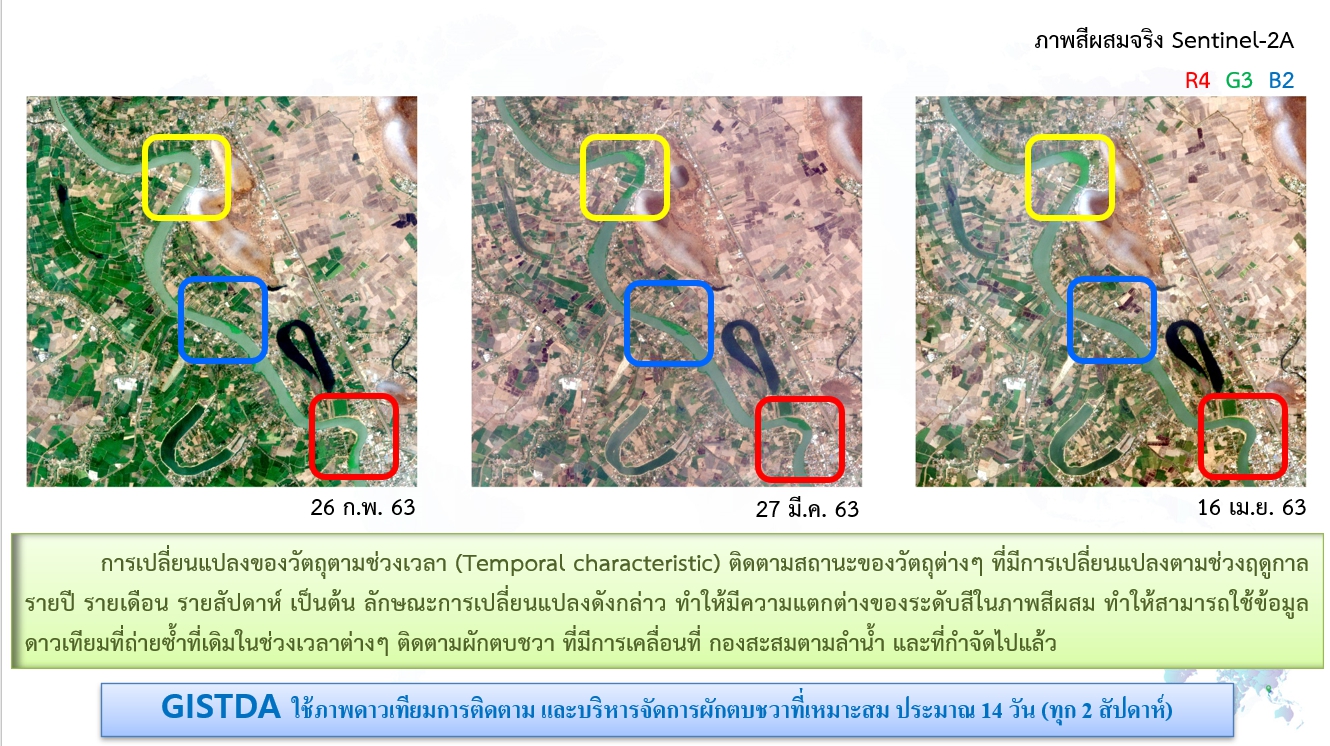Meaning
There are many words that are synonyms of remote sensing: distant recognition, remote data survey, teleceptor, etc. The Thai Royal Institute uses the first one, “distant recognition.”
Remote sensing is a scientific and art acquisition of materials, land and phenomena on earth surface from Sensor without touching the targeted materials, based on electromagnetic energy that is a medium of data acquisition and has three characteristics: spectral characteristics, spatial characteristics and temporal characteristics.
Remote Sensing Process and Elements
Remote Sensing Process and Elements consist of:
Data acquisition is processed through electromagnetic wave from energy sources such as the sun. It (a) moves through atmosphere, (b) interacts with energy and earth surface features, (c) enters the sensor installed in plane, spaceship and satellite, (d) is recorded and produces the pictorial data or photograph and/or digital form. (e)
Data analysis consists of visual interpretation and digital analysis (f) using related data that is referencing data such as estate map, calendar and crop planting statistical data and others. Finally, it gets products (g) of interpretation in the forms of map, numerical data, table, description or chart for utilization. (h)
Energy Sources and Radiation Principles
Wavelength
Electromagnetic wave (as shown in Figure 3.2) is a continuous power that has wavelength starting from several meters to fraction of billion meters (Nanometr: 10-9 meters). The sun is the most important source of natural electromagnetic energy and remote sensing that radiates power based on electromagnetic theory divided into Wave Theory and Particle Theory. The remote sensing mainly uses Wave Theory that focuses on harmonic motion that has equal repeated range and rhythm in a particular time. Its speed is as same as light speed (c). Distance from the crest of wave to the next crest called wavelength (λ) and amount of wave crest moving from a particular point to one another per time unit called wave frequency (f) relating to wave speed:
Λ = C/F
λ = wavelength
c = stable wave speed at 3 x 108 meter/second
f = wave frequency (cycle/sec or hertz)
According to equation above, wavelength and frequency have inverted relationship, that is, if the wavelength is long, the wave frequency is less. Wavelength unit is called Micrometer or Micron (μ), 0.000001 meter or 10-6 meters. Detailed wavelength in metric is described in the table.
| หน่วย | ความยาว |
| กิโลเมตร (km) | 1,000 m |
| เมตร (m) | 1.0 m |
| เซนติเมตร (cm) | 0.01 m = 10-2 |
| มิลลิเมตร (mm) | 0.001 m = 10-3 |
| ไมโครเมตร (μm) | 0.000001 m = 10-6 |
| นาโนเมตร (nm) | 10-9 |
| อังสตรอม (A°) | 10-10 |
Electromagnetic wave is divided based on wavelength called Band. Started from the shortest band, cosmic rays that has 10-10 meter length, to band at many kilometers. The waves are categorized based on its length: gamma ray, X-ray and ultraviolet ray. Visual waves are infrared, microwave and radio wave.

ภาพลักษณะของคลื่นแม่เหล็กไฟฟ้า (Electromagnetic spectrum)

ภาพช่วงคลื่นของคลื่นแม่เหล็กไฟฟ้า
Wavelength used in remote sensing are divided into two groups:
Optional wavelength at 0.4-14 micrometers photographs by film and sensor consists of wavelength reacting to human’s eyes or visible light at 0.4-0.7 micrometer, which is separated into three spans: blue, green and red.
Near infrared or reflecting infrared at 0.7-3 micrometers and thermal infrared at 3.-15 micrometers has wavelength between 1 millimeter and 1 meter. This group always uses unit of frequency that is different from wave optics using unit of wave length, radar system, which records wavelength data at 3-12.5 GHz (wavelength at 2.4-100 centimeters). Alphabets are used to symbolize the wavelength as follows:
Wavelength K Frequency 12.5-40 GHz or Wavelength 0.70-2.4 centimeters
Wavelength X Frequency 8 – 12.5 GHz or Wavelength 2.4-3.75 centimeters
Wavelength C Frequency 4-8 GHz or Wavelength 3.75 – 7.5 centimeters
Wavelength S Frequency 2-4 GHz or Wavelength 7.5-15 centimeters
Wavelength L Frequency 1-2 GHz or Wavelength 15-30 centimeters
Wavelength P Frequency 0.3-1 GHz or Wavelength 30-100 centimeters
ตารางช่วงคลื่นแม่เหล็กไฟฟ้า และคุณสมบัติ
| ช่วงคลื่น | รายละเอียด | รายละเอียด |
| รังสีแกมม่า (Gamma ray) | < 0.03 ไมโครเมตร | รังสีแกมม่าถูกดูดซึมทั้งหมดโดยบรรยากาศชั้นบน |
| รังสีเอกซ์ (X-ray) | 0.03-3.1 ไมโครเมตร | รังสีเอกซเรย์ถูกดูดซึมทั้งหมดโดยชั้นบรรยากาศเช่นกัน |
| รังสีเหนือม่วง หรือรังสีอัลตราไวโอเลต | 0.03-0.4 ไมโครเมตร | ช่วงคลื่นสั้นกว่า 0.3 ไมโครเมตร ถูกดูดซึมทั้งหมดโดยโอโซน(O3) ในบรรยากาศชั้นบน |
| ช่วงคลื่นไวโอเลตภาพถ่าย(Photographic UV band) | 0.3-0.4 ไมโครเมตร | ช่วงคลื่นสามารถผ่านชั้นบรรยากาศ สามารถถ่ายภาพด้วยฟิล์มถ่ายรูป แต่การกระจายในชั้นบรรยากาศเป็นอุปสรรคมาก |
| ช่วงคลื่นตามองเห็นได้ | 0.4-0.7 ไมโครเมตร |
บันทึกภาพด้วยฟิล์มและอุปกรณ์บันทึกภาพได้รวมทั้งช่วงคลื่นโลกมีการสะท้อนพลังงานสูงสุด (Reflected energy peak) ที่ 0.5 ไมครอน ช่วงคลื่นแคบที่มีผลตอบสนองสายตามนุษย์ แบ่งได้ 3 ช่วงคือ0.4-0.5 ไมโครเมตร (สีน้ำเงิน)0.5-0.6 ไมโครเมตร (สีเขียว) 0.6-0.7 ไมโครเมตร (สีแดง) |
| อินฟราเรด | 0.7-1.00 ไมโครเมตร | มีปฏิสัมพันธ์กับวัตถุตามความยาวคลื่นและการผ่านชั้นบรรยากาศ มีการดูดซึมในบางช่วงคลื่น |
| ช่วงคลื่นอินฟราเรดชนิดสะท้อน(Reflected IR band) | 0.7-3.0 ไมโครเมตร | สะท้อนรังสีดวงอาทิตย์ ซึ่งไม่มีรายละเอียดเกี่ยวกับช่วงความร้อนของวัตถุช่วงคลื่น 0.7-0.9 ไมโครเมตร สามารถถ่ายรูปด้วยฟิล์ม เรียกว่า ช่วงคลื่นอินฟราเรด (Photographic IR band) |
| ช่วงคลื่นอินฟราเรดความร้อน | 3-5 ไมโครเมตร8-14 ไมโครเมตร | การบันทึกภาพต้องใช้อุปกรณ์พิเศษ เช่น เครื่อง วาดภาพ |
| ไมโครเวฟ | 0.1-30 เซนติเมตร | ช่วงคลื่นยาวสามารถทะลุผ่านหมอกและฝนได้ บันทึกภาพได้ทั้งระบบเอ็กทิฟและระบบแพสซิฟ |
| เรดาร์ | 0.1-3.0 เซนติเมตร | ระบบแอ็กทิฟมีความยาวช่วงคลื่นต่างๆ เช่น Ka band (10 mm), X band (30 มิลลิเมตร) และ L band (25 เซนติเมตร) |
| วิทยุ (Radio) | > 30 เซนติเมตร | ช่วงคลื่นที่ยาวที่สุด บางครั้งมีเรดาร์อยู่ในช่วงนี้ด้วย |
Electromagnetic Wave Radiation
Radiation of electromagnetic wave can be described by Particle Theory. It consists of free unit called Photon or Quantum. Energy of each quantum is a direct proportion with wave frequency as follows:
E = HF
E = 1-Quantum energy in Joules
h = Planck’s constant = 6.626 x 10-34 J.sec
f = wave frequency
or may be changed to be in the form of wavelength: E = hc/λ
The energy is an inverted ratio with wavelength: long wavelength has low energy. If a material has long wavelength such as microwave, energy examination by remote sensing tools through long wavelength is more difficult than the short one. Recording long-wavelength energy should then be done in wide areas and lasts long time. The sun is the most important electromagnetic wave source of remote sensing. However, all substances having temperature higher than absolute zero (0 K or - 273 ํC) can continuously release electromagnetic energy with different size and element of wavelength. The amount of released electromagnetic energy depends on temperature of material surface, which can be calculated by the rule of Stefan Boltzmann as follows:
W = ΣT4
W = ALL ENERGY RELEASED FROM MATERIAL SURFACE WM-2
Σ = CONSTANT STEFAN-BOLTZMANN; 5.6697 X 10- 8 WM-2 K-4
T = TEMPERATURE OF MATERIAL (K)
The direct radiation from material with the fourth power temperature presents that there is a dramatically increase when temperature is increased. This rule is also used with black body materials, which are assuming objects absorbing all incident energy and dispersing most energy at multilevel temperature. In fact, there is no material having this qualification. Some materials merely have similar qualification, that is, the dispersing energy is inverted with temperature and wavelength of the material.
The dispersing energy inverts with material’s temperature and has different spectrum distribution or spectrum ratio inverted with temperature of material. Figure 3.4 presents relationship between wavelength and all energy dispersing from material surface and supreme energy of materials, distribution of spectrum from the temperature at 200 K to 6,000 K, showing relationship between wavelengths and radiating energy per 1 micrometer of the wavelength using Wm-2 μm-1 unit. Therefore, the areas beneath curve presents all dispersing energy. It obviously presents that material or high-temperature radiating tools give more energy. According to the figure, when temperature is increased, the peak will incline to short wavelength side.
However, energy per area unit for a particular wavelength can be calculated through the rule of Planck as follows:
C1 constant = 3.74 x 10 -16 W.m2
C2 contant = 1.44 x 10 -2 m.K
T = Temperature (K)
Wλ = energy having wavelength λ
It indicates that temperature and wavelength have an impact on inverted dispersing energy. If knowing temperature, it is possible to calculate wavelength giving maximum energy from Wien’s displacement law as follows:
ΛM = C/T
ΛM = WAVELENGTH GIVING MAXIMUM ENERGY
C = CONTANT 2.898 X 10-3 M.K
EXAMPLE 1: TEMPERATURE AT EARTH SURFACE IS 300 K, SO
ΛM = (2.898 X 10 -3)/ 300 M
= 9.66 X 10 -6 M
= 9.66 MICROMETERS (THERMAL INFRARED WAVELENGTH) OR APPROXIMATELY 10 MICROMETERS
Therefore, the temperature of earth surface (vegetation, soil and water) at 300 ํK has maximum energy at approximate 10-micrometer wavelength or thermal infrared wavelength since there is a relationship between radiation and heat on the earth surface. This radiating way is called Thermal Infrared Energy, which cannot be measured by camera record using general film, but it can be measured by the record of special tools such as radiometer or drawing machine. The sun has maximum energy at 0.5-micrometer wavelength. This length of wave is sensitive to human’s eyes and general film. As a result, whenever the sun rises, we can see the earth surface because of reflection of solar power. The energy that has longer wavelength can also radiate from earth surface, but it can be measured by other systems, not general film as aforementioned. Separation between reflecting infrared wavelength and thermal infrared emphasizes the measurement of radiation from material for approximate 3 micrometers (If wavelength is shorter than this, most rays are reflecting infrared. If it is higher than this, the infrared radiates from the material itself.). In general, sensing system measuring energy reflecting from material and natural radiation is called Passive System. The sun or energy radiating itself having sensing system producing energy and sending it to the targeted material, is called Active System such as radar system that sends synthesized energy to hit the targeted material; then detects the backscatter.
ที่มา : ตำราเทคโนโลยีอวกาศและภูมิสารสนเทศศาสตร์



